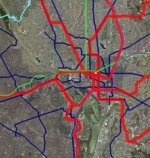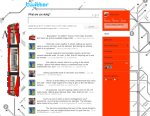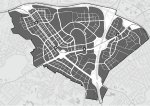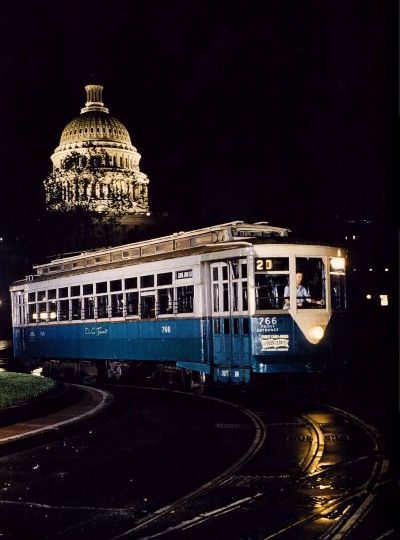|
Special Features





Image Libraries


|
|
Blog
In 2006 the gross domestic product for the Washington, DC region (the sum value of all goods and services produced regionally that year) was $367 billion. That includes the suburbs, but not Baltimore nor its suburbs. Assuming 2006 was a fairly typical year:
- Metro’s request for $11 billion in maintenance money over the next 10 years equates to about three-tenths of one percent of the regional economy.
- The approximately 190 miles of streetcar lines BeyondDC proposes in our Transit Vision, costing a very very back-of-the-napkin $6 billion, equate to less than two-tenths of one percent of the regional economy over 10 years, or about 1.6% of one-year’s economy.
- The Washington region alone could pay off the entire federal economic bailout in about two years.
- Each of the 5.3-some million people in the region produce, on average, about $70, 000 per year in economic activity.
Of course, these aren’t apples-to-apples comparisons. We physically can’t spend all our collective economic energy in one place (gotta eat, after all). The amount of money available to the government to spend discretionarily is much, much smaller than the overall total gross economy. But still, interesting stuff.
Average Rating: 4.4 out of 5 based on 228 user reviews.
September 30th, 2008 | Permalink
Tags: economy, government, transportation

In light of the latest attempt by Congress to pass a Metro funding bill, Richard Layman makes an interesting point:
“U.S. Congress ordered the dissolution of the DC streetcar system in the early 1950s, after choosing to not renew the franchise, ostensibly in response to a worker strike. (The system was replaced with buses completely in 1962.) This means to my way of thinking that the Federal Government has a special responsibility for rebuilding transit in the region, because the Federal Government has responsibility for the wrecking of fixed rail transit in the region.”
Average Rating: 4.7 out of 5 based on 293 user reviews.
September 30th, 2008 | Permalink
Tags: government, transportation

|

Part of the Transit Vision as seen in Google Earth |
When we released the BeyondDC Transit Vision we included two maps showing our proposed transit system, an abstracted diagram and a true geographic map. Since then we’ve heard some readers have had trouble understanding where some of our proposed routes go, and that the geographic map is too hard to read at the scale provided and without labels.
In response, we’ve prepared a downloadable .kmz map. Download the file, open it in Google Earth, and then navigate in and out to your heart’s content.
A couple of notes:
- We put this together pretty quickly, based more or less on eyeballing routes. It’s not as exact as the original geographic map, which we made in GIS. The point here is just to show folks where lines go.
- Red is Metrorail, dark blue is streetcar, teal is light rail, green is BRT, and purple is regional rail
- Refinement is never ending. For this version of the map we’ve added one line not shown on any others – a spur of the H streetcar route (call it H3) cutting down New Hampshire Avenue from U Street to Foggy Bottom.
Average Rating: 4.6 out of 5 based on 182 user reviews.
September 29th, 2008 | Permalink
Tags: site, transportation

|

Lynchburg: Where dedicated local NoVa transportation money will be spent on education. Wait, what? |
When the Virginia Supreme Court nullified the NVTA‘s ability to collect taxes earlier this year, it struck a major blow to Northern Virginia’s hopes for new infrastructure.
That was a few months ago. Since then construction projects have been put on hold and hundreds of millions of dollars have been returned to Virginia taxpayers. However, BeyondDC has it on good authority that:
1) While most of NVTA’s money was automatically refunded, certain pots of it have to be specifically claimed by individual taxpayers. Funds totaling several million dollars have not yet and are unlikely to be claimed, leaving NVTA with some fairly sizable amount of money leftover.
2) Thanks to an article in Virginia’s state constitution, all leftover money of that sort must be given over to an education fund that mostly benefits rural communities in southwest Virginia. So after the refund process is over, NVTA can’t even spend what money it has left, and must instead send it down to Richmond.
So, just so we’re clear, millions of dollars raised in Northern Virginia by Northern Virginians specifically for the purpose of locally funding transportation projects in Northern Virginia, is now being taken by Richmond for dispersal in southwest Virginia.
BeyondDC is all for education programs that benefit rural communities, but for goodness sake, this money was raised locally specifically because Richmond doesn’t pay Northern Virginia its fair share of state-wide revenue. Northern Virginia ponied up to create a dedicated local funding stream to pay for what should be state responsibilities, and what happened? The state swooped in, literally stole the cash, and left Northern Virginia to its wounds (and precious few new transportation facilities).
Welcome to the Commonwealth; the ridiculous, irresponsible, intellectually bankrupt, downright broken Commonwealth.
Average Rating: 4.8 out of 5 based on 220 user reviews.
September 25th, 2008 | Permalink
Tags: government, transportation

|

Statue near the Tennessee state house. |
Photos from an early-summer Nashville trip in two sets: Downtown and core neighborhoods.
Judgment: Passable downtown and pretty bungalow stock, but few real mixed-use neighborhoods.
Average Rating: 5 out of 5 based on 152 user reviews.
September 24th, 2008 | Permalink
Tags: galleries

|

The result of NIMBYism’s rule. |
Take a look at America’s new breed of third world style shantytown. It’s a tent village in Reno, Nevada populated by homeless with nowhere else to go. Get used to the image, because villages like it are popping up in cities all across the country.
Meanwhile, developers continue to build oversized, over-expensive housing rather than reasonable housing for the middle class. They do this because local governments around the country continue to outlaw affordable housing via exclusionary zoning practices that make modestly-sized homes difficult or impossible to construct. Local governments, in turn, have exclusionary zoning because local citizens demand it, or at least accept it.
When so-called starter homes look like this, it’s no wonder we’re in a foreclosure crisis. The American housing market cannot adequately supply housing affordable to the American workforce because Americans are busy demanding that only luxurious products be delivered. As a result, a smaller number of Americans are living in bigger houses, while a larger number of formerly middle class Americans fall through the cracks.
This is just a suggestion, but maybe we should rethink exclusionary zoning. The next time your town discusses residential development, for goodness sake, argue for more, smaller units.
Average Rating: 4.8 out of 5 based on 290 user reviews.
September 20th, 2008 | Permalink
Tags: economy, government, law

|

Who doesn’t love Twitter? |
Remember those problems BeyondDC had a little while ago? It occurred to us that if the site ever goes down again we’d still like to communicate with readers. Therefore, beginning today you can follow BeyondDC on Twitter. We won’t tweet every time there’s a new blog post (that’s what RSS is for); instead, readers can expect from our twitter feed an independent line of thought – musings on urbanism in 140 characters or less.
And of course, updates if the site goes down.
Average Rating: 4.6 out of 5 based on 241 user reviews.
September 19th, 2008 | Permalink
Tags: site

Every six years Congress adopts a surface transportation bill that guides federal transportation revenue and spending, including allocation of money collected by the federal gas tax. The current incarnation of that bill is called SAFETEA-LU, and is set to expire about a year from now. SAFETEA-LU is pretty similar to its six-year predecessor, TEA-21, which was itself pretty similar to its predecessor, ISTEA. The numbers change, but for the most part the feds haven’t changed how they do business in a long time.
When Congress convenes in 2009 a new TEA bill (that’s Transportation Equity Act, BTW) will be near the top of its agenda. But the world of 2008 isn’t the same as was the world of previous TEAs. Climate change is proven science, gas prices are way up, the highway trust fund is broke, drive-til-you-qualify no longer applies, and transit agencies are shattering ridership records left and right.
If Congress doesn’t come through with a major rewrite it won’t just be a disappointment, it will be an epic failure of government.
|
|
It’s clear that no matter who wins in November, this time around Congress will have to think outside the box. America needs a new TEA bill that recognizes and responds to the world around us, not a copypasta reauthorization of the same spending deal we functioned under during different times. If Congress doesn’t come through with a major rewrite it won’t just be a disappointment, it will be an epic failure of government, and a violation of the trust of the American people.
If Congress acts responsibly, it will have to address the following five big questions:
- Do we need more money, or only wiser money?
Transit and multi-modal projects obviously need more money, but to get it do we need more money generally, or should we shift money currently being spent on highways over to other uses? If we eliminate pork like the bridge to nowhere, is there enough for legitimate needs, or will we still require more dollars?
- Is the gas tax the best (or only) way to raise money?
As Americans drive less and use more fuel-efficient vehicles, federal gas tax revenue is declining. One potential solution is to raise the gas tax, but USDOT Secretary Mary Peters thinks we should ditch the gas tax and charge tolls on all major roadways. There are a lot of potential benefits to tolls. They’re a more direct user fee, they reward people for driving less as opposed to buying a hybrid and driving just as much, they should be more stable than the gas tax over the long term, and they’re scalable to congestion – you can charge a higher toll if there’s more traffic. Should we do one, the other, or both?
- Should there be modal parity?
For years the TEA bills have had separate highway funds and transit funds, but the two funds have never been treated equally. Not only is the highway budget vastly larger, but harnessing money from it is a matter of right for every state, whereas localities must compete for transit money. States are currently awarded highway money according to a formula. If Virginia’s population pays in $x to the trust fund via gas taxes, Virginia automatically gets $y back to spend on road projects. On the other hand, there is so little transit money that if a state (like, say Virginia) wants to build a transit line (like, say the Silver line), it has to go through a stringent competition / regulation process to convince FTA overlords of its worthiness. Want to build a highway? Knock yourself out, here’s the cash. Want to build a Metro? Spend the next decade doing paper work, and then maybe. Congress must decide if this non-mode-neutral system is still in America’s best interests.
- Should MPOs get the bulk of money instead of state DOTs?
State Departments of Transportation are, almost uniformly speaking, bureaucratic monsters that are rarely able to respond adequately to the needs of metropolitan regions. Even under the best circumstances, DOTs dictate local needs from faraway capitals. But metropolitan regions are the driving force of America’s economy these days, and home to the bulk of America’s population. It is becoming more and more clear that transportation money to be spent in metropolitan regions should be controlled from the regions themselves. Sure sure, let the state DOTs handle true intercity routes and rural connectors, but why should Arlington have to beg Richmond for money that theoretically should belong to Arlington in the first place? Federal regulations already require MPOs to manage transportation planning in metropolitan regions; should they manage the money too?
- Should climate change legislation affect transportation?
Of course it should! Transportation-related emissions are one of the chief culprits of global warming. But how? Both presidential candidates have expressed interest in carbon cap and trade concepts, but only Obama’s suggests carbon allotments be auctioned and the proceeds used to fund clean energy alternatives. Could those alternatives include transit? Why not use carbon auction money to fund the next generation of rapid transit lines in American cities? Or a national high-speed rail network? Or anything. Cap and trade, if it happens, will probably happen as a separate piece of legislation rather than as part of the TEA bill, but it will be the same Congress debating both bills. Why not use one for the other?
Five big questions; five answers we need to get right if America hopes to compete in a future without limitless, cheap gasoline. This is a story sure to continue, so stay tuned.
Average Rating: 5 out of 5 based on 285 user reviews.
September 18th, 2008 | Permalink
Tags: environment, government, transportation

|

Bryant Park, or Tysons Corner?

Proposed Tysons land use.

Proposed new street grid. |
Tysons Corner is the most important activity center in the Washington region after downtown DC itself. Tysons has more office space than all but about a dozen of the country’s largest downtowns, and is one of the nation’s biggest retail meccas. It is the thousand-pound gorilla in our midst, and cannot be ignored just because it’s in Fairfax County.
Because Tysons in such a behemoth, transforming it from a wasteland of parking lots into legitimate urbanism (that can accommodate more density and therefore reduce sprawl) is one the highest Smart Growth priorities in the region. It’s why providing top-quality transit access via the Silver Line is the essential next-step of Metro’s expansion, and why Fairfax County is committed to the Tysons Land Use Task Force’s Transforming Tysons Vision, which at its most basic level calls for a more pedestrian-friendly, mixed-use Tysons Corner reminiscent of a bona fide downtown.
Greater Greater Washington opined about the plan last week, now it’s BeyondDC’s turn. We’re not going to bother explaining the plan (y’all can read it on your own), but will just jump right in with our comments:
- Tysons is so geographically huge that the entire area is unlikely to transform, so the Vision correctly identifies intensity nodes around each proposed Metro station. It strikes BeyondDC that as this plan becomes reality, we may need to begin thinking of Tysons as a string of neighborhoods in the ilk of Rosslyn-Ballston rather than as a single place.
- Even if the main part of Tysons along Route 7 and near the two malls manages to coalesce into a something that feels like a single place, the portion east of the Beltway will always be separate; very few will ever walk from East Tysons to Tysons Galleria.
- Sooner or later we’re going to need names for these nodes that people can use. Tysons East, Tysons Central 123, Tysons Central 7 and Tysons West are too cold. Who wants to be from a neighborhood named after a highway number, adjacent to another neighborhood named after a highway number? As suggestions, we’ll toss out (from east to west) Scott Run, Galleria Center, Westpark and Spring Hill.
- Quality urbanism cannot be had with super-sized blocks, so the new street grid is absolutely essential, and welcome to see. For the most part the proposed streets are pretty well placed, though more connections to adjacent neighborhoods would help Tysons not to seem so insolated.
- If Tysons is to truly become Downtown Virginia, it will need more than just office towers, condos and department stores. The plan correctly identifies that one of the things currently lacking in Tysons is anything related to civic life. That includes parks and squares of course, but also libraries, post offices, etceteras. Fairfax County should commit to a government presence in Tysons. The next time a new courthouse or supervisor’s chambers are necessary, put them Downtown.
- Though the Vision illustrates mitigations to Routes 7 and 123 that will help those streets be more like Champs-Élysées than I-66, the interchange at Routes 7 and 123 remains a problem. It is a giant barrier, cutting off northwest Tysons from the south and east. Sooner or later the interchange will have to be removed.

Possible cross section of Route 7 or 123.
The “Old Courthouse South” subarea – the part of the Route 7 corridor southeast of the 123 interchange – is a big problem because currently it’s part of the very heart of Tysons, but is too distant from a Metro station to be considered a redevelopment priority. Though it will be a project for the next generation, eventually a light rail line on Route 7 between Tysons and Columbia Pike will likely be necessary.
To extend the reach of transit beyond the Metro station areas, the plan proposes a series of circulator bus routes. A necessary step, definitely, and it’s encouraging that the Vision proposes circulators operate in dedicated lanes (streets in Tysons are certainly wide enough). Looking at the proposed circulator route map, though, we’re a little worried it’s too complex. Several circulator routes may be necessary, but if so the DOT folks will need a Metrorail-like circulator system map to visually clarify the clutter of routes.
The open space plan is encouraging because it focuses primarily on providing a large number of small squares / pocket parks, rather than just one or two big tree-saves.
The vision includes a height limit chart, with taller buildings allowed close to Metro stations (as it should be). But even on top of stations, buildings are limited to 400 feet in height. That’s OK as long as our goal is to fill out the parking lots and wasted space of Tysons by building lots of individual buildings rather than 1 or 2 super skyscrapers, but it won’t take too many decades before all the good Metro-adjacent locations are built-out. When that day comes it will be time to reevaluate the height limit. Why shouldn’t Tysons have skyscrapers, after all?
We could go on, but overall the Vision pretty much says the things it needs to say. If Fairfax County follows this plan, Tysons Corner will eventually be at least the equal of Rosslyn-Ballston, which would be a huge accomplishment. The tough part will be sticking to the plan.
Average Rating: 5 out of 5 based on 150 user reviews.
September 16th, 2008 | Permalink
Tags: government, transportation, urbandesign

Things that happened during our downtime that aren’t to be missed:
Average Rating: 4.8 out of 5 based on 253 user reviews.
September 12th, 2008 | Permalink
Tags: transportation, urbandesign

|
Media





Site
About BeyondDC
Archive 2003-06
Contact
Category Tags:
Partners
|























